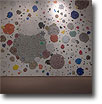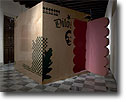Trienal Poli/Gráfica de San Juan,
Oct 01, 2004 - Dec 01, 2004
San Juan, Puerto Rico
Poetic Odyssey at the San Juan Triennial 2004
by Elvis Fuentes
Taking the oldest competitive printmaking event in Latin America as a base, Puerto Rico has returned to the cutting edge of a contemporary printmaking discourse when the Graphics Biennial was transformed into the Trienal Poli/Gráfica de San Juan: América Latina y el Caribe (began October 2004). Teresa Tió, a Puerto Rican poster historian and the author of this renovation, turned to Mari Carmen Ramírez, director of the Art Center for the Americas at the Museum of Fine Arts in Houston for help. Ramírez restructured the event and invited four curators to prepare the central exhibition for this edition, Justo Pastor Mellado (Chile), Harper Montgomery (U.S.A.), José Ignacio Roca (Colombia) and Margarita Fernández Zavala (Puerto Rico). Zavala was also in charge of preparing an anthological exhibition of graphics on the island. Curators Laura Buccelato (Argentina) and Marta Calderón (Colombia) took charge of the solo shows dedicated, respectively, to Antonio Berni and Beatriz González. There are a series of prints on the facade of the Arsenal de la Marina at La Puntilla in Old San Juan. These are the Frenazos (Sudden Halts or Hitting the Brakes) by Regina Silveira (Brazil), a body of work that summarizes many of themes proposed by the curators in the central exhibition, Trans/Migraciones: la gráfica como práctica artística contemporánea, (Trans/Migrations: Printmaking as a Contemporary Artistic Practice). Frenazos will also serve us as a leit motif that leads the viewer through the curatorial axis of the Triennial’s central exhibition and oblige us to visit eight buildings in the Borinquen capital. Routing sheet 1: Links
Hitting the brakes intimates the automobile, a source of transportation and of pollution, both air and noise, but also suggests the criss-crossing of streets and avenues outlining urban sites. We thus think of a map of the city, which differs for the resident and for the tourist - due to the places they frequent, for example - or for the pedestrian and the driver, since each has his routes of circulation laid out: pedestrian crossings, express ways, stairs, dead-end streets, tunnels. El cazador (The Hunter), by Carlos Garaicoa (Cuba) focuses on interlinking these flows into a web. This work consists of a performance by the mime Giacomo Ricci, who hauled a house lined with mirrors through the streets and sidewalks of the old city. From its walls, three video cameras filmed the surrounding landscape in movement. Once in the gallery, the house became a matrix of projections on walls, bringing inside images from the journey into the space and reflecting them in the mirrors. This visual game between negative and positive, original and reproduction, is a conceptual reference to printmaking and the mirrored relationship between the press and the impression. The map as an arguable representation of geopolitical reality is explored in the work Mundillo desencajado, Europa II (Unwoven embroidery, Europa II), by Antonio Martorell (Puerto Rico). This piece consists of embroidery created in a circle technique that is specific to Puerto Rico and made by expert craftswomen who followed a pattern drawn by the artist. In the proposed design, the placement of countries had been altered and the fragility of the piece itself extends to its actual borders. Martorell is present in numerous forms at the Triennial. The curators, in fact, wanted to recognize him as one of the continent’s pioneers in graphic experimentation. The theme of popular or folk traditions seen in handicrafts - cutting and sewing - is touched upon in two of his works, the Casa Singer (The Singer House) and the Paper Dolls series. The first is a baroque altar-installation, dedicated to the sewing machine and its contribution to the domestic economy. In contrast, the Paper Dolls series refers to the games of dressing and undressing the models
|











